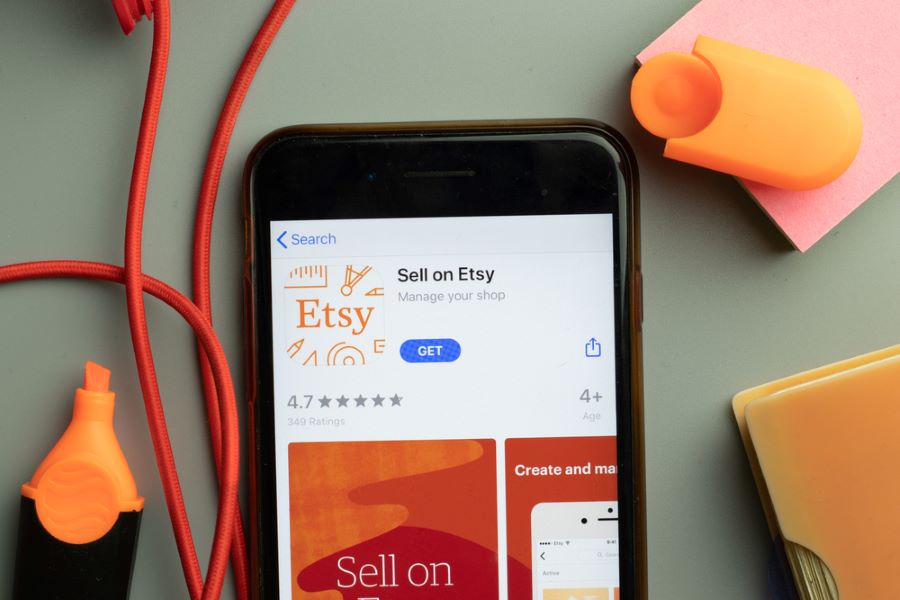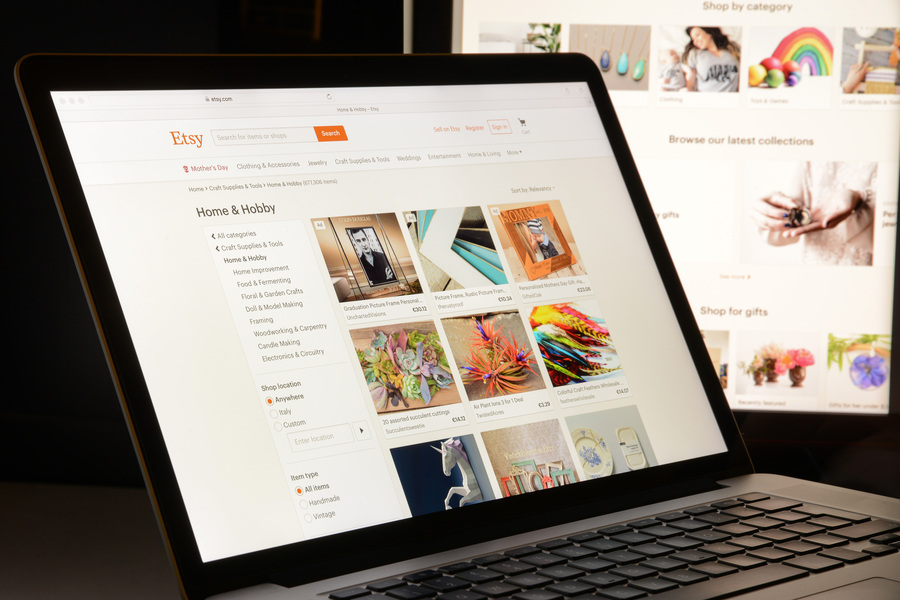Etsy is a popular online marketplace specializing in unique handcrafted items, vintage goods, and craft supplies. With millions of active buyers, setting up an Etsy shop offers a great opportunity for creative entrepreneurs to showcase and sell their products to a wide audience. Whether you are an artist, jewellery maker, or vintage collector, opening an Etsy shop can provide a platform to connect with potential customers and establish your online presence. In this guide, we will walk you through the step-by-step process of setting up your Etsy shop, from choosing a shop name to optimizing your product listings for better visibility. So, let’s start creating your successful online shop on Etsy.

Why open an Etsy Shop?
Opening an Etsy Shop can be an excellent opportunity for creative individuals looking to sell their handmade items, crafts, and unique products. With its user-friendly platform and low initial costs, Etsy provides a valuable platform for sellers to showcase their creations and connect with potential customers worldwide.
One of the main reasons to open an Etsy Shop is its user-friendly interface. Even for those who are not tech-savvy, setting up and managing an Etsy Shop is relatively easy. The platform provides a step-by-step guide to help you navigate the process and get your shop up and running quickly.
Another advantage of opening an Etsy Shop is the low upfront costs. Unlike traditional brick-and-mortar stores, there is no need to invest in expensive rent or overhead costs. All you need is a computer or smartphone and an internet connection. With an Etsy Shop, you can start selling your products without breaking the bank.
Furthermore, Etsy has a large and active customer base, making it a profitable seller niche. Many people turn to Etsy for unique and handcrafted items that cannot be found in regular retail stores. By tapping into this market, you can increase your sales volume and generate a steady income.
Opening an Etsy Shop is worth it for any creative individual looking to showcase and sell their unique products. With its user-friendly platform, low, upfront costs, and profitability potential, Etsy provides an ideal platform to reach a wide audience and grow your business.
Create Your Etsy Shop
Opening an Etsy Shop is a simple process that allows creative individuals to showcase and sell their products to a global audience. Here is a step-by-step guide on how to create your Etsy shop:
To start, visit the Etsy website and click the “Sell on Etsy” button. This will take you to the sign-up page where you can create your seller account.
After signing up, you will be prompted to choose your shop preferences. These include selecting the language and currency that best suits your target market. It’s important to set these preferences accurately to provide a seamless shopping experience for potential buyers.
Following these steps, you can easily create your Etsy shop and start selling your handmade items, crafts, and unique products to a worldwide audience. Don’t forget to optimize your shop for search engine optimization, market your products on social media platforms, and provide excellent customer service to attract and retain customers.
Choosing a Name and Language
When setting up an Etsy shop, one of the crucial steps is choosing a name that represents your brand and sets you apart from the competition. Additionally, selecting the default language for your shop plays a significant role in attracting potential buyers.
To choose a name for your Etsy shop, brainstorm words or phrases that relate to your products or the overall theme of your brand. It’s important to select a name that is catchy, memorable, and easy to spell. Ensure the name aligns with your target market and evokes the right emotions.
While choosing a name, you should also consider the default language for your shop. Selecting the appropriate language ensures that potential buyers can easily navigate your shop and understand your product listings. If you have a specific target market, it’s advisable to choose the language that they predominantly use.
If your desired shop name is already taken, don’t worry! Etsy provides alternative options, such as adding a location or a descriptive word to your name. Brainstorm different variations that still reflect your brand identity.
In summary, when setting up your Etsy shop, take the time to choose a name that represents your brand’s uniqueness and select the appropriate default language to attract potential buyers. Brainstorm alternative options if your desired name is not available. These steps will help set a solid foundation for your Etsy shop.

Add Product Listings
Once you have chosen a name for your Etsy shop, it’s time to start adding product listings. Product listings are the heart of your shop and showcase the items you’re selling. To create an effective product listing, write a compelling title that accurately describes what you’re selling. Use descriptive and specific keywords to help potential customers find your products through the search bar.
Next, write detailed and engaging product descriptions highlighting your items’ unique features, materials used, and special characteristics. Be sure to include measurements, colours, and any other relevant information. Along with your descriptions, high-quality product photos are essential to attract potential buyers. Take clear and well-lit images that show your items from different angles.
Consider using props or styling to enhance the visual appeal. Lastly, don’t forget to set an appropriate price for your products, considering the item’s cost, shop policies, and any shipping costs or fees. Creating appealing and informative product listings increases your chances of attracting buyers and successful sales on Etsy.

Creating Product Descriptions for Your Etsy Shop
When setting up your Etsy shop, crafting effective product descriptions is crucial to attract potential customers and drive sales. A well-written description informs buyers about your products and enhances their shopping experience. Here’s a step-by-step guide to creating compelling product descriptions:
Start with detailed information: Provide accurate measurements, colour descriptions, condition, age, and uses of your products. This helps customers make informed decisions and reduces the chance of returns or dissatisfaction.
Utilize keywords: Incorporate relevant keywords in your descriptions to improve search engine optimization (SEO) and increase the visibility of your products. Research popular search terms and infuse them naturally within the description.
Specify your target audience: Tailor your descriptions to appeal to your desired customer base. Consider your ideal buyers’ demographics, interests, and preferences and craft your language accordingly.
Highlight unique materials or techniques: If your products are made with special materials or techniques, showcase these qualities in your descriptions. This sets your items apart and generates interest among potential customers.
Include dimensions and shipping information: Clearly state the dimensions of your products to manage customer expectations. Additionally, provide shipping details such as estimated delivery times and any additional costs or options available.
Explain how to purchase the product: Walk customers through the purchasing process, directing them to click the “Add to Cart” button or any other necessary steps. Provide instructions on how to select variations, if applicable, and any personalization options.
Use clear, concise, and descriptive language: Keep your descriptions concise while conveying all essential information. Double-check for correct spelling and grammar to maintain a professional image.
Add relevant tags: Incorporate descriptive tags directly related to your products. This helps potential buyers find your listings when using the Etsy search bar.
By following these steps, you can create engaging and informative product descriptions that captivate potential buyers, facilitate sales, and contribute to the success of your Etsy shop.
Make good pictures
Creating good product pictures to attract potential buyers and showcase your items in the best possible light is important when setting up your Etsy shop. Follow these key steps to ensure your product photos are top-notch:
Ensure clarity: Take clear, well-lit photos that accurately represent your products. Customers should be able to see the details clearly and understand what they are purchasing.
Capture different angles: Take photos from multiple angles and provide a 360-degree view of your products. This helps customers better understand the item’s shape, size, and design.
Use a white background: Opt for a clean, white background for your product photos. This helps your items stand out in search results and gives your shop a professional and cohesive look.
Include multiple photos: Aim to have at least five to ten photos per product. This allows customers to see different aspects of the item and helps build trust and confidence in their purchase decision.
Optimize photo size: Resize your product photos to around 1,000 square pixels for optimal quality. This ensures your images load quickly and look sharp on desktop and mobile devices.
By following these steps and incorporating keywords such as “good product photos,” “clear photos,” “different angles,” “white background,” and “360 views,” you can create compelling product pictures that capture the attention of potential buyers and increase sales in your Etsy shop.
Payments and fees
When setting up your Etsy shop, it’s important to understand the payment and fee structure to manage your business effectively. Etsy offers various payment options for both buyers and sellers. As a seller, you can accept Etsy Payments, which allows customers to pay with credit cards, debit cards, Etsy gift cards, and some alternative payment methods. You can also opt to enable PayPal as a payment method. Etsy Payments simplifies the checkout process for buyers and provides a streamlined payment experience.
It’s important to note that fees are associated with using Etsy Payments, including payment processing and transaction fees. Additionally, there may be a listing fee for each product you list in your shop. Make sure to familiarize yourself with Etsy’s fee structure and policies to ensure you understand the costs associated with running your shop. You can find detailed information on fees and payments in Etsy’s Seller Handbook.
It’s important to note that fees are associated with using Etsy Payments, including payment processing and transaction fees. Additionally, there may be a listing fee for each product you list in your shop. Make sure to familiarize yourself with Etsy’s fee structure and policies to ensure you understand the costs associated with running your shop.

Pricing Your Products and Handling Shipping Costs
Setting up an Etsy shop involves more than just creating product listings. Accurately pricing your products and effectively handling shipping costs are important aspects of running a successful online business. Here are some tips to help you navigate these crucial steps:
Research and Compare Shipping Costs: Before deciding on your shipping costs, it is essential to research and compare the shipping rates of similar vendors. This will ensure that your prices are competitive and appealing to potential customers. Take note of the product’s weight, dimensions, and destination when comparing rates.
Use a Shipping Rate Calculator: Consider using a shipping rate calculator to provide customers with accurate and up-to-date shipping costs. These tools help you determine the cost based on the weight, dimensions, and shipping destination. By inputting these details, you can offer more accurate pricing to your customers.
Include Shipping Costs in Product Listings: Include the shipping costs for each item when creating your product listings. Transparency is key in attracting potential buyers and avoiding confusion or surprise charges. Offering free or discounted shipping options can also be an effective strategy to entice customers.
Benefits of Free or Discounted Shipping: Free or discounted shipping options can entice potential buyers. Research shows that shoppers are more likely to complete a purchase when free or discounted shipping is offered. Consider including the shipping cost in your item’s price and adjusting the listing accordingly.
You can attract more customers and increase sales on your Etsy shop by pricing your products accurately and handling shipping costs effectively. Regularly review and update your pricing and shipping strategies to stay competitive.
| Type of Fees | Etsy fees |
|---|---|
| Monthly fee | Etsy Standard: Free Etsy Plus: USD $10 /month |
| Product listing | Fees vary per country |
| Transaction fee | 6.5% of the total order amount in your designated listing currency |
| Card processing fee (Etsy Payments) | fees vary per country |
| Currency conversion | 2.5% fee |
Increasing the Visibility of Your Shop
Increasing the visibility of your Etsy shop is crucial for attracting potential buyers and growing your business. Here are some strategies you can implement to boost your shop’s visibility:
Optimize Your Product Titles and Descriptions: Ensure that your product titles and descriptions include relevant keywords that potential buyers are likely to search for. This will help your listings appear higher in search results and attract more traffic to your shop.
Use High-Quality Product Photos: High-quality and visually appealing product photos are essential for capturing the attention of potential buyers. Invest in good lighting, staging, and editing to showcase your products in the best possible way and increase their desirability.
Utilize Search Engine Optimization (SEO): Incorporate relevant keywords in your shop’s tags, titles, and descriptions to improve its visibility in search engine results. Conduct keyword research to identify popular and relevant search terms and use them strategically throughout your shop.
Promote Your Shop on Social Media: Take advantage of social media platforms like Instagram, Facebook, and Pinterest to showcase your products and drive traffic to your Etsy shop. Create visually appealing posts, engage with your audience, and leverage relevant hashtags to increase your reach and attract potential buyers.
Participate in Etsy Promoted Listings: Etsy Promoted Listings is an advertising tool that allows you to boost the visibility of your products within the Etsy marketplace. Set a budget, select the products you want to promote, and Etsy will display them more prominently in search results.
Collaborate with Influencers or Bloggers: Team up with influencers or bloggers in your niche with a strong following and ask them to feature your products. Their endorsement and exposure can significantly increase your shop’s visibility and attract new customers.
By implementing these strategies, you can increase the visibility of your Etsy shop, attract a larger audience, and ultimately grow your business.
Optimizing Search Bar Results
Optimizing Search Bar Results on Etsy can greatly enhance your shop’s visibility and attract potential buyers. Here are some key steps to follow:
Utilize Relevant Keywords and Tags: Incorporate relevant keywords and tags in your item listings attributes. This will help your products appear in search results when buyers use specific search terms.
Regularly Update Your Shop: Keep your shop and listings updated with fresh and relevant content. Adding new products frequently not only keeps your shop active but also improves your shop’s visibility in search results.
Provide a Good Customer Experience: Excellent customer service is vital. Respond promptly to inquiries, address concerns, and provide accurate product information. Satisfied customers are likelier to leave positive reviews and recommend your shop to others.
Encourage Buyers to Leave Reviews: Positive reviews can significantly boost your shop’s credibility. Encourage buyers to leave reviews by sending follow-up messages after their purchase. Their feedback can influence potential buyers and improve your shop’s search ranking.
Complete Your “About Me” Page: Completing your “About Me” page gives potential buyers a sense of who you are as a seller. This creates a personal connection and builds trust, increasing their likelihood of purchasing from your shop.
By following these steps and consistently optimizing your shop’s search bar results, you can attract more potential buyers and increase your chances of success on Etsy.

Attracting Potential Buyers
By implementing these strategies, you can attract potential buyers to your Etsy shop and increase your chances of making sales. Remember to continuously analyze and adjust your marketing strategies based on customer feedback and market trends.
Use Social media
Social media platforms are essential for promoting your Etsy shop and reaching a wider audience. Here are three main social media platforms that you should consider using:
Instagram: With its visual focus, Instagram is perfect for showcasing your products. Create a business account and post high-quality photos of your products, engaging captions and relevant hashtags. Engage with followers by responding to comments and messages, and use Instagram’s shopping features to tag your products in posts and stories.
Facebook: As one of the largest social media platforms, Facebook provides a great opportunity to connect with potential customers. Create a Facebook page for your brand and invite friends, family, and other contacts to like and follow your page. Post product photos, updates about new arrivals, and promotions. Engage with your audience by responding to comments and private messages.
Pinterest is a highly visual platform that allows users to discover and save content. Create boards related to your products and pin high-quality images with links to your Etsy shop. Optimize your pins with relevant keywords and descriptions to increase visibility. Consider joining group boards and collaborating with influencers or other businesses in your niche to expand your reach.
While having a presence on all three platforms is ideal, it is recommended to start with just one platform and focus on growing your audience there. Engage with your followers, share appealing product photos, and provide updates about your shop regularly to build awareness and drive traffic to your Etsy shop.


